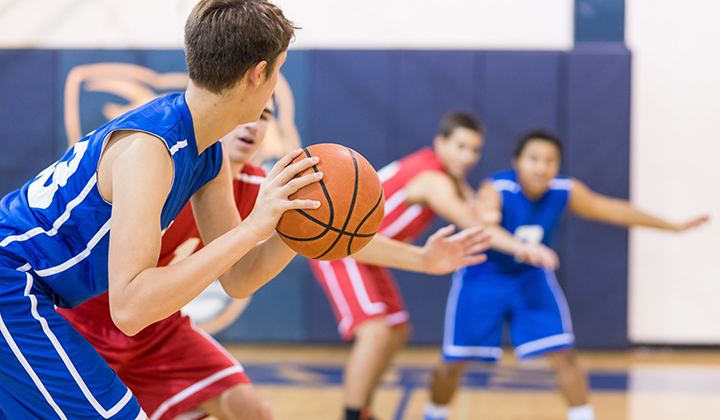
Updated November 30, 2020. For the most updated COVID-19 information, please visit childrensmercy.org/coronavirus
As our climate seasons change, so do our sport seasons. With the onset of cooler temperatures, indoor sports are starting to gear up. Typically, this transition is not much of an issue, but as we know 2020 has not been the standard by any means.
COVID-19 cases continue to rise in our community and there is still such a broad range with the disease from no or mild symptoms to a very significant and life-threatening symptoms. At the Children’s Mercy Sports Medicine Center, we recommend all state and local government orders and directives continue to be followed.
In the Kansas City metro area, it has been recommended by several of the local health departments indoor sports should not be played. Since this is a recommendation rather than an order, there are several areas, organizations, districts and schools moving forward with indoor sports.
So, as a parent, how should you decide what is best for your student-athlete and what can you do to keep them as healthy as possible?
Participation in sports has known health benefits ranging from physical fitness to mental wellness. Sports provide a social construct and interaction which is necessary in a time of uncertainty for our youth athletes. Despite the benefit of sport and social interaction, we also recognize there are ongoing infection risks and concerns regarding COVID-19.
Indoor sports bring a completely new set of challenges and realities to consider when it comes to the pandemic. By playing indoors the risk of spread increases, as it is difficult to remain physically distanced, 6 feet or greater, team sizes with coaching staffs are typically larger than 10 people and they are practicing or competing in a shared ventilation system. With indoor sports like wrestling and basketball, it is also hard to avoid breathing heavily in close contact with others, which is another increased risk.
Regardless of where the sport is being played, an athlete should not attend or participate in any group athletic activity if they are feeling ill (COVID-19 symptoms include a 100.0 fever or higher, cough, difficulty breathing or other symptoms outlined by the CDC), have been exposed to COVID-19 in the last 14 days or are unsure about potential symptoms or exposure. Athletes, parents and coaches have a social, moral and ethical responsibility to report all COVID-19 symptoms and exposures.
When preparing for practice or competition, here are some tips each athlete should follow:
- Each individual athlete should make sure they have no symptoms.
- At a minimum, thoroughly wash your hands with soap and water (minimum 20 seconds) OR use hand sanitizer before AND after practice or competition.
- Clean and wipe down any equipment, before AND after practice or competition.
- Do NOT share water bottles, equipment, towels, etc.
- Avoid touching your face or any object unless necessary and wash your hands after.
- No high fives, fist bumps or chest bumps.
- Maintain physical distancing from teammates, coaches and other players when taking breaks and between games.
- Masks should be worn when athletes are on the bench (during games) and when not participating in practice.
- Personal equipment should be cleaned with disinfectant before and after each use.
- Avoid community equipment use when possible. If not possible, equipment should be cleaned before AND after each individual use. An exception is ball use. For these sports - wipe down balls between drills, different users or have individual use ball availability, if possible.
- Individual towel use only.
Since these events are taking place indoors, it is our recommendation that no spectators be allowed during practices or games due to the increased potential spread of the virus. However, if physical distancing can be maintained, local guidelines are followed, and your athlete’s school is allowing spectators – we strongly recommend limiting these numbers and that there is universal masking.
These ideas are meant to supplement considerations by your state and local governing bodies and health departments and are not meant to replace them. Rely on information at your own risk, consult the most up-to-date recommendations from your own state and local public health officials. If still in doubt, speak with your physicians about any specific issues or questions you may have.
Let’s play healthy, Kansas City!
A special thank you to the additional members of the return to sports task force: Nicole Fillingame, MS, LAT, ATC, CES, PES – Sports Medicine Outreach & Athletic Training Manager; Natalie Stork, MD, FAAP – Sports Medicine Physician

